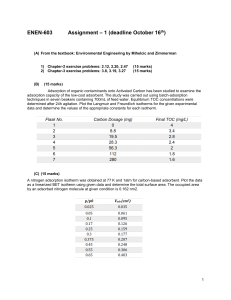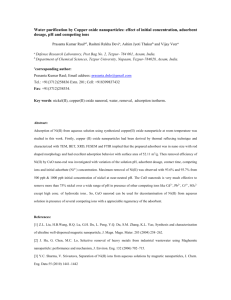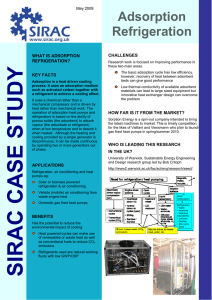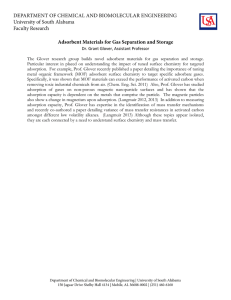Uploaded by
International Research Journal of Engineering and Technology (IRJET)
Galvanized Wastewater Treatment: Adsorption Study
advertisement
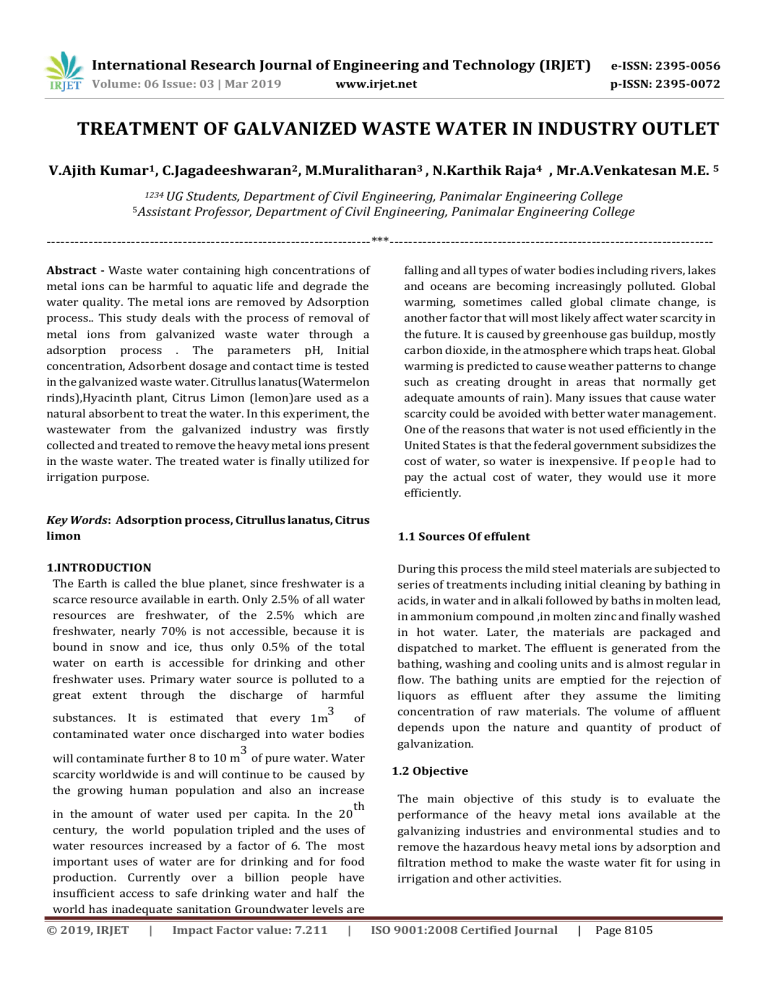
International Research Journal of Engineering and Technology (IRJET) e-ISSN: 2395-0056 Volume: 06 Issue: 03 | Mar 2019 p-ISSN: 2395-0072 www.irjet.net TREATMENT OF GALVANIZED WASTE WATER IN INDUSTRY OUTLET V.Ajith Kumar1, C.Jagadeeshwaran2, M.Muralitharan3 , N.Karthik Raja4 , Mr.A.Venkatesan M.E. 5 1234 UG Students, Department of Civil Engineering, Panimalar Engineering College Professor, Department of Civil Engineering, Panimalar Engineering College 5Assistant ---------------------------------------------------------------------***--------------------------------------------------------------------Abstract - Waste water containing high concentrations of metal ions can be harmful to aquatic life and degrade the water quality. The metal ions are removed by Adsorption process.. This study deals with the process of removal of metal ions from galvanized waste water through a adsorption process . The parameters pH, Initial concentration, Adsorbent dosage and contact time is tested in the galvanized waste water. Citrullus lanatus(Watermelon rinds),Hyacinth plant, Citrus Limon (lemon)are used as a natural absorbent to treat the water. In this experiment, the wastewater from the galvanized industry was firstly collected and treated to remove the heavy metal ions present in the waste water. The treated water is finally utilized for irrigation purpose. Key Words: Adsorption process, Citrullus lanatus, Citrus limon 1.INTRODUCTION The Earth is called the blue planet, since freshwater is a scarce resource available in earth. Only 2.5% of all water resources are freshwater, of the 2.5% which are freshwater, nearly 70% is not accessible, because it is bound in snow and ice, thus only 0.5% of the total water on earth is accessible for drinking and other freshwater uses. Primary water source is polluted to a great extent through the discharge of harmful 3 substances. It is estimated that every 1m of contaminated water once discharged into water bodies 3 will contaminate further 8 to 10 m of pure water. Water scarcity worldwide is and will continue to be caused by the growing human population and also an increase th in the amount of water used per capita. In the 20 century, the world population tripled and the uses of water resources increased by a factor of 6. The most important uses of water are for drinking and for food production. Currently over a billion people have insufficient access to safe drinking water and half the world has inadequate sanitation Groundwater levels are © 2019, IRJET | Impact Factor value: 7.211 | falling and all types of water bodies including rivers, lakes and oceans are becoming increasingly polluted. Global warming, sometimes called global climate change, is another factor that will most likely affect water scarcity in the future. It is caused by greenhouse gas buildup, mostly carbon dioxide, in the atmosphere which traps heat. Global warming is predicted to cause weather patterns to change such as creating drought in areas that normally get adequate amounts of rain). Many issues that cause water scarcity could be avoided with better water management. One of the reasons that water is not used efficiently in the United States is that the federal government subsidizes the cost of water, so water is inexpensive. If peopl e had to pay the actual cost of water, they would use it more efficiently. 1.1 Sources Of effulent During this process the mild steel materials are subjected to series of treatments including initial cleaning by bathing in acids, in water and in alkali followed by baths in molten lead, in ammonium compound ,in molten zinc and finally washed in hot water. Later, the materials are packaged and dispatched to market. The effluent is generated from the bathing, washing and cooling units and is almost regular in flow. The bathing units are emptied for the rejection of liquors as effluent after they assume the limiting concentration of raw materials. The volume of affluent depends upon the nature and quantity of product of galvanization. 1.2 Objective The main objective of this study is to evaluate the performance of the heavy metal ions available at the galvanizing industries and environmental studies and to remove the hazardous heavy metal ions by adsorption and filtration method to make the waste water fit for using in irrigation and other activities. ISO 9001:2008 Certified Journal | Page 8105 International Research Journal of Engineering and Technology (IRJET) e-ISSN: 2395-0056 Volume: 06 Issue: 03 | Mar 2019 p-ISSN: 2395-0072 www.irjet.net 2. LITERATURE REVIEW 4.Electro Coagulation Process Velmurugan. P, et al., (2011) conducted a study on removal of chloride from using low cost adsorbent. The adsorbent were prepared from orange, banana, and hyacinth leaves. The effects of pH, contact time, adsorbent dosage were experimented. It was concluded that the orange peel is very effective compared to others, as the maximum removal found to be 99%.It was also concluded that the optimum pH, time and adsorbent dosage was at 6.5 pH, 45 min, and 1 grams respectively. The effects of contact time, bed height, column diameter and pH were investigated. For the effect of pH, it was concluded that the rate of removal of acid orange– II is very high at pH 7 because of its in neutral medium. For the effect of time, it was concluded that the removal of acid orange–II decreases due to the minimum time of contact between adsorbent and adsorbate. An electrode is an electrical conductor used to make contact with a nonmetallic part of a circuit. In case of EC, electrodes are known to be sacrificed for the release of metal ions at the anode, and cathode is responsible to produce hydroxyl ions. Metallic electrodes sacrificed to produce ions in the water which ultimately neutralized the charges of suspended particles leading to coagulation. Water molecules are usually in bonding with colloidal particles, oils, or other contaminants in the wastewater leading to stable suspension, EC caused ionization of the water molecules adhering the contaminants to convert them into insoluble moieties to be sediment under gravity or float depending on density. ‘HEAVY METAL IONS ADSORPTION FROM WASTEWATER USING ACTIVATED CARBON FROM ORANGE PEEL’ - Juan carlos moreno-Piraján , and Liliana giraldo 3.ADSORPTION PROCESS “Adsorption” may be defined as the process of accumulation of any substance giving higher concentration of molecular species on the surface of another substance as compared to that in the bulk. When a solid surface is exposed to a gas or a liquid, molecules from the gas or the solution phase accumulate or concentrate at the surface. The phenomenon of concentration of molecules of a gas or liquid at a solid surface is called adsorption. It is a well-established and powerful technique for treating domestic and industrial effluents. In water treatment, the most widely method is Adsorption” onto the surface of activated carbon. The substance that concentrates at the surface is called adsorbate. The material upon whose surface the adsorption takes place is called an adsorbent. Adsorption is a mass transfer process which involves the accumulation of substances at the interface of two phases, such as, liquid-liquid, gas liquid, gas-solid or liquid-solid interface. The properties of adsorbates and adsorbents are quite specific and depend upon their constituents. If the interaction between the solid surface and the adsorbed molecules has a physical nature, the process is called physisorption. In this case the attraction interactions are vanderwaal forces and, as they are weak the process results are reversible. Furthermore, it occurs lower or close to the critical temperature of the adsorbed substance. © 2019, IRJET | Impact Factor value: 7.211 | ADVANTAGES OF ELECTRO COAGULATION ➢ Electrocoagulation requires simple equipment and small area as compared to the conventional pond system which causes increase in the greenhouse gases. ➢ Electrocoagulation is an alternative wastewater treatment that dissolves metal anode using electricity and provides active cations required for coagulation without increasing the salinity of the water. ➢ Electrocoagulation has the capability to remove a large number of pollutants under a variety of conditions ranging from: suspended solids, heavy metals, petroleum products, colour from dye-containing solution, aquatic humus and defluoridation of water. 5. EXPERIMENTAL SETUP 5.1REMOVAL LANATUS OF AMMONIUM USING CITRULLUS The removal of ammonium process will start from adsorption method by using natural adsorbent. Watermelon rinds and citrus lemon for the removal of ammonium from waste water were collected from market area. The rinds were washed with tap water and rinsed with distilled water to remove impurities. Next, the samples were cut into small pieces (around 1 to 2 mm) and dried in an oven at 40°C for 48 hours to a constant weight. For chemically modified adsorbent, the material was soaked in 1 L NaOH solution (20mmol/L), 1 L KOH solution (20mmol/L) and 1 L H 2SO4 solution (20mmol/L) respectively for 24 hours. The watermelon rind was then dried further in an oven at 40°C for 48 hours. Synthetic ammonium solutions were used throughout the adsorption tests. First, ammonium chloride salt (NH4Cl) mixed with distilled water were used for the ISO 9001:2008 Certified Journal | Page 8106 International Research Journal of Engineering and Technology (IRJET) e-ISSN: 2395-0056 Volume: 06 Issue: 03 | Mar 2019 p-ISSN: 2395-0072 www.irjet.net preparation of a stock NH3-N solution of 50 mg/L. Then, the experimental solutions at the desired ammonium concentrations were prepared by diluting the stock solution with distilled water. The initial pH was adjusted to 7.0 using dilute solutions of NaOH (0.1 N) throughout the experiments. Prior to the addition of adsorbents all the samples were adjusted to optimum pH value. In order to determine the residual concentration by using UV-Spectrophotometer at maximum wavelength of 425nm, the solution was taken at certain intervals. Hence, the amount of ammonia nitrogen is adsorbed at equilibrium. 5.2 REMOVAL OF CHLORIDE The adsorbent, for this trial, is set up as enacted carbon. As the crude material for the planning of initiated carbon is an oceanic weed, the creation of this carbon is financially plausible. The water hyacinth plants are gathered from a close-by lake. It is then sundried for around one week. The plants are then washed a few circumstances with clean water to evacuate the soil, mud, greeneries, and so forth. Ensuing washing with refined and twofold refined water are additionally done to expel the monotonous material. It is then dried. Corrosive Activation: About 25 grams of this material is treated with 20ml of concentrated sulphuric corrosive and the scorched material was kept overnight. The singed material is warmed in a broiler at 100˚C for around 46 hours. This is cooled and washed with refined water to expel any hint of corrosive, so that the pH goes in the vicinity of 6 and 8, which is appropriate for the assurance of chloride by argentometric strategy. The principle motivation behind corrosive initiation is to guarantee a very protonated surface on the adsorbent material. Higher adsorption rate of chloride in the acidic range can be clarified by the surface charge of the adsorbent. By corrosive treatment the surface of the adsorbent is very protonated and subsequently more chloride can be pulled in to the surface of the adsorbent. High chloride sorption rate in the acidic medium is contributed because of solid columbic drives between decidedly charged surface and adversely charged chloride particles. Subsequently corrosive enactment guarantees higher effectiveness in the evacuation of chloride particles. Warm enactment is done to get ready actuated carbon with a distinct pore structure having proficient adsorption limit. The initiation gives a material of high surface territory and solid sorption limit towards different adsorbates. A substantial surface region builds the adsorption rate, which is guaranteed just because of warm actuation. © 2019, IRJET | Impact Factor value: 7.211 | 6. CONCLUSIONS In this process we have analyze the results of Adsorption process and concluded that though Adsorption process is cost effective in removing the highly concentrated metal ions and acid like iron, ammonium and chloride from Galvanized waste water .Galvanized waste water can be treated and reused by using these process which helps to reduce the parameter level which will satisfy the required need of reuse of water. The optimum parameters for this study were: contact time: 90 minutes, Adsorbent dosage: 60mg/l, Initial concentration of iron33mg/l With a maximum removal capacity of 72%, Initial concentration of Ammonia 23mg/l With a maximum removal capacity of 54%, Initial concentration of chloride 771mg/l With a maximum removal capacity of 86%. Experimental process indicated that the adsorption process provided the best description of the data. REFERENCES [1].A.Latha,S.Vanathi,K.Swathi, Treatment of galvanized waste water by Membrane Distillation .2017 [ Removal of iron precipitation in galvanized waste water by membrane filtration process ] [2]. Sogaard, G.E., R. Medenwaldt, and J.V. Abraham-Peskir, Conditions and rates of biotic and abiotic iron precipitation in selected Danish freshwater plants and microscopic analysis of precipitate morphology. Water Research, 2000. 34(10). [ Concentration of iron precipitation in fresh water and contaminated water] [3]. D.H. Belhateche, Choose appropriate wastewater treatment technologies, Chemical Engineering Progress 8 (1995) . [4]. Z. Ding, L.Y. Liu, Z.M. Li, R.Y. Ma, Z.R. Yang,Experimental study of ammonia removal from water by membrane distillation (MD): The comparison of three configurations, Journal of Membrane Science 286 (1-2) (2006) [ The process of ammonia removal by using watermelon rinds as a natural adsorbent ] [5]. Mr.M.Shanmugasundaram ,Dr.K.Sudalaimani Assistant Professor, Vickram College of Engineering, Enathi. Associate Professor, Thiagarajar College of Engineering Madurai: A ISO 9001:2008 Certified Journal | Page 8107 International Research Journal of Engineering and Technology (IRJET) e-ISSN: 2395-0056 Volume: 06 Issue: 03 | Mar 2019 p-ISSN: 2395-0072 www.irjet.net study of natural adsorbents for the removal of chloride ion in water. © 2019, IRJET | Impact Factor value: 7.211 | ISO 9001:2008 Certified Journal | Page 8108


